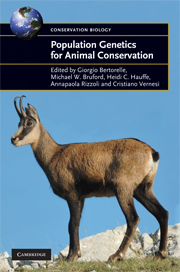Book contents
- Frontmatter
- Epigraph
- Contents
- List of contributors
- Foreword
- Acknowledgements
- 1 Introduction
- Statistical approaches, data analysis and inference
- Molecular approaches and applications
- From genetic data to practical management: issues and case studies
- Future directions in conservation genetics
- Software index
- Species index (common name)
- Species index (Latin name)
- Subject index
1 - Introduction
Published online by Cambridge University Press: 05 July 2015
- Frontmatter
- Epigraph
- Contents
- List of contributors
- Foreword
- Acknowledgements
- 1 Introduction
- Statistical approaches, data analysis and inference
- Molecular approaches and applications
- From genetic data to practical management: issues and case studies
- Future directions in conservation genetics
- Software index
- Species index (common name)
- Species index (Latin name)
- Subject index
Summary
When it comes to advocating animal conservation, it is difficult to be convincing without becoming alarmist. The fact is, time is running out for many of the world's animal species. Habitat loss, introduced species, overexploitation and pollution, all caused by human activities, combine with stochastic factors to place ever-increasing pressure on natural populations (Primack 2002). The estimates of the mid-1990s, predicting that thousands of species and millions of unique populations would go extinct in the following decades (Ehrlich and Wilson 1991; Smith et al. 1993; Lawton and May 1995), remain as relevant as when they were first made, and we are still living in an era of unprecedented biodiversity loss, with current extinction rates 100–1000 times the background rate (Primack 2002) and 5000–25 000 times that recorded in the fossil record (Frankham et al. 2002; but see Mace et al. 1996). Recently, however, there have been some positive signs in the media that biologists’ warnings are being received (e.g. Gianni 2004; Devine et al. 2006; Black 2006; Gabriel 2007; Stern 2007), and a rapid and efficient approach in providing information pertinent to biodiversity preservation could be pivotal in policy decision and in optimizing resource allocation (Naidoo and Ricketts 2006; Marsh et al. 2007). Since the foundation of the field of conservation biology, it has been argued that a synergy between conservation biology and advanced population genetics could provide important information that policy-makers need. As should be obvious by its title, the purpose of this book is an attempt to go some way towards maturing such a synergy; hence, this introduction presents a brief history and the current state of this partnership.
THE EXTINCTION CRISIS
In order to be convinced of the urgency for animal conservation and the information necessary to practise it, an update on the current extinction crisis is pertinent.
- Type
- Chapter
- Information
- Population Genetics for Animal Conservation , pp. 1 - 22Publisher: Cambridge University PressPrint publication year: 2009

